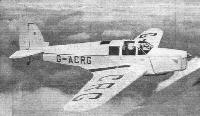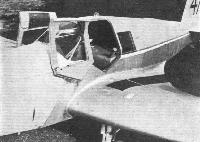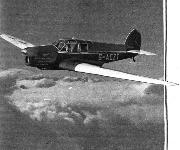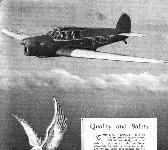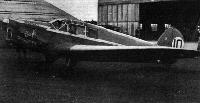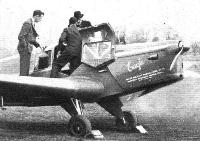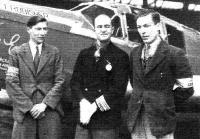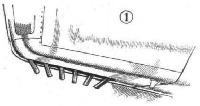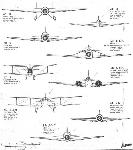
Описание
Страна : Великобритания
Год : 1934
Трехместный спортивный и туристический самолет
Варианты
- British Klemm - BK-1 Eagle - 1934 - Великобритания
- British Aircraft - Cupid - 1935 - Великобритания
British Aircraft (British Klemm) B.K.1 Eagle
Легкий многоцелевой самолет British Klemm В.К.1 Eagle стал достаточно интересным созданием британских авиаконструкторов. Как и у его предшественника Swallow, конструкция В.К.1 Eagle была деревянная, с полотняной обтяжкой поверхностей управления. Самолет представлял собой моноплан с трехместной кабиной и выпускаемыми вручную основными стойками шасси. В базовом варианте силовая установка включала один рядный двигатель de Havilland Gipsy Major в 130 л.е., с ним в начале 1934 года в первый полет отправился и прототип машины.
"Люксовая" модификация самолета, Eagle 2, появилась после того, как компания была переименована в "British Aircraft Manufacturing Со.". Новая модель получила специально подготовленный двигатель, что позволило самолету победить в нескольких предвоенных авиагонках.
Однако высокая скорость была не единственным достоинством этой машины, которая также отличалась высокой надежностью и относительно большой дальностью полета. На одном самолете был выполнен одиночный перелет из Австралии в Новую Зеландию, над Тасмановым морем; на другом был совершен рекордный перелет через Южную Атлантику, а еще один использовался Кацутаро Ано для перелета по маршруту Хэнворт (Великобритания) - Токио (Япония).
В общей сложности было выпущено 42 самолета, из них пять В.К.1 и тридцать семь В.А.2 Eagle 2. Их них 17 машин были поставлены на экспорт, а в годы Второй мировой войны не менее семи остававшихся в Великобритании самолетов были мобилизованы на службу в Королевские ВВС. Еще два самолета мобилизовали для участия в войне в Индии и по одному в Кении и Малайе.
ТАКТИКО-ТЕХНИЧЕСКИЕ ХАРАКТЕРИСТИКИ
British Aircraft Eagle 2
Тип: трехместный спортивный и туристический самолет
Силовая установка: один рядный двигатель de Havilland Gipsy Major мощностью 130 л. с. (97 кВт)
Характеристики: максимальная скорость на оптимальной высоте 238 км/час; крейсерская скорость на оптимальной высоте 209 км/час; начальная скороподъемность 213 м/мин; практический потолок 4875 м; дальность 1046 км
Масса: пустого 658 кг; максимальная взлетная 1089 кг
Размеры: размах крыла 11,96 м; длина 7,62 м; высота 2,06 м; площадь крыла 18,58 м2
Описание:
- British Aircraft (British Klemm) B.K.1 Eagle
- Flight, July 1934
NEW AEROPLANES IN KING'S CUP RACE - Flight, April 1936
MODERN LIGHT AIRCRAFT REVIEWED - Flight, March 1938
British light aircraft
Фотографии
-
Aeroplane Monthly 1999-10 / S.McKay - Ben Cooper /Obituary/
Регистрационный номер: G-AFAX [4], VH-ACN [4] BA Eagle G-AFAX was one of Ben Cooper’s most distinctive restorations.
-
Aeroplane Monthly 1997-03 / M.Oakey - Vintage news
Регистрационный номер: VH-UTI [2] Air World’s BA Eagle II, VH-UTI, has been bought by New South Wales-based Roy Fox.
-
Flight 1934-07 / Flight
Регистрационный номер: G-ACPU [2] Another Selection of King's Cup Machines (4) British Klemm "Eagle," D.H. "Gipsy Six" 200 h.p. engine.
-
Aeroplane Monthly 1988-04 / Personal album. Civil
Регистрационный номер: G-ACPU [2] British Klemm B.K.1. Eagle 1 G-ACPU was the first production Eagle. It was certificated in July 1934 and first sold to E. L. Gandar Dower, who ordered it for racing. It was thus fitted with a 200 h.p. Gipsy VI, but this was later replaced by a standard 130 h.p. Gipsy Major. In September 1941 'PU was impressed into the RAF as 2679M.
-
Flight 1935-01 / Flight Advertisements
Регистрационный номер: G-ACRG [6] -
Flight 1934-06 / Flight
Регистрационный номер: G-ACRG [6] FAST COMFORT: Retractable undercarriage, highly tapered wings and clean lines, especially over the pilot's cockpit, are some of the many features which give the new British Klemm "Eagle" ("Gipsy Major") its fine performance.
-
Flight 1934-11 / Flight
Регистрационный номер: G-ACRG [6] -
Flight 1934-08 / Flight
Регистрационный номер: G-ACRG [6] ABOVE THE CLOUDS: In this view the fine lines of the British Klemm "Eagle" (130 h. p. "Gipsy Major") are particularly noticeable, and some idea can be gained of the pilot's range of vision, both above and below. The "Eagle's" cruising speed, with "Gipsy Major" engine, is 130 m.p.h.
-
Flight 1934-07 / Flight
Регистрационный номер: G-ACRG [6] IN A NEW WORLD: The British Klemm "Eagle" (Gipsy "Major") flying above the clouds.
-
Flight 1935-01 / Flight Advertisements
Регистрационный номер: G-ACRG [6] 3 seater cabin de luxe. Retractable undercarriage. Speed range 45-170 m.p.h. ?1259 with Gipsy Major. ?1475 with Gipsy Six.
-
Air-Britain Archive 1984-04
Регистрационный номер: G-ACVU [4] Optimistic British entrant was the B.K.Eagle G-ACVU owned by the Middlesborough steel company of William Shaw & Co Ltd.
-
Flight 1934-10 / Flight
Регистрационный номер: G-ACVU [4] SPIRITUAL: Flt. Lt. Shaw's British Klemm "Eagle," The Spirit of W. Shaw & Co., Ltd., which is one of the most completely equipped machines in the race.
-
Авиация и Космонавтика 2013-10 / В.Морозов - Великая воздушная гонка
Регистрационный номер: G-ACVU [4] Кинооператоры снимают Клемм "Игл" накануне старта
-
Flight 1934-09 / Flight
Регистрационный номер: G-ACVU [4] FOR THE HANDICAP RACE: The British Klemm "Eagle" ("Gipsy Major"), to be flown by Flt. Lt. G. Shaw, has been fitted with extra petrol tanks, bringing the total capacity up to 70 gallons.
-
Flight 1935-04 / Flight Advertisements
Регистрационный номер: G-ACZT [5] Было построено 37 самолетов Eagle 2, первым был G-ACZT. Этот самолет был оборудован в варианте "люкс".
-
Flight 1935-04 / Flight Advertisements
Регистрационный номер: G-ACZT [5] -
Flight 1935-05 / Flight Advertisements
Регистрационный номер: G-ACZT [5] -
Flight 1935-05 / Flight
Регистрационный номер: G-ADFB Mr. Katsutaro Ano, a Japanese pilot (right) is shortly to attempt to establish a flying record between England and Japan in his "Eagle" monoplane.
-
Flight 1936-10 / Flight Advertisements
Регистрационный номер: G-ADJO [2] EASY ACCESS: CABIN OPENS WITH DOORS
-
Flight 1937-06 / Flight
Регистрационный номер: G-ADJO [2] The two Eagles (Flt. Lt. Rose and Mr. H. J. Wilson up) get away from Ronaldsway on the Manx race. Though they have hardly crossed the boundary - and have not started to put on bank for the turn on to course - the undercarriages are up.
-
Aeroplane Monthly 1998-12 / M.Hooks - Weekend jolly /Inter-war civil/
Регистрационный номер: HB-DES Part of the visiting aircraft park at Heston. Visible are Hornet Moths EC-BBF and OE-DKS, BA Eagle HB-DES, Klemm KI 32 D-EREQ, Heinkel Kadett D-EQOS, Leopard Moths HB-ARI and HB-EFE, and Waco UIC PH-MAG.
Другие самолёты на фотографии: De Havilland Hornet Moth / D.H.87 - Великобритания - 1934De Havilland Leopard Moth / D.H.85 - Великобритания - 1933Heinkel He-72 Kadett - Германия - 1933Klemm Kl.32 / Kl.36 - Германия - 1932WACO C / S Series - США - 1931
-
Air-Britain Archive 1981-01
Регистрационный номер: VH-ACN [4], G-AFAX [4] In Archive No.4 the BA Eagle II G-AFAX was featured and this is now VH-ACN with the Chewing Gum Field Air Museum at Tallebudgerra, Queensland where Dave photographed it in September 1980.
-
Aeroplane Monthly 1990-07 / M.Oakey - Grapevine
Регистрационный номер: VH-ACN [4], G-AFAX [4] BA Eagle 2 VH-ACN is coming together at Hungerford, where Ben and Jan Cooper are restoring it for Cathay Pacific pilot Capt Geoff Green. Acquired by Green at the Chewing Gum Field Aircraft Museum auction 3yr ago, the rare Eagle was built in 1937 and originally registered G-AFAX.
-
Aeroplane Monthly 1987-11 / M.Oakey - Grapevine
Регистрационный номер: VH-ACN [4], G-AFAX [4] B. A. Eagle VH-ACN, seen here at the Chewing Gum Field Aircraft Museum in 1985, is returning to the UK for restoration to flying condition.
-
Air-Britain Archive 1981-04
Регистрационный номер: VH-USP, ZK-AEA BK Eagle VH-USP made the first solo trans-Tasman crossing by a NZ national on 18.10.35. It was photographed at Milson during a tour of NZ in early 1936 before being repainted briefly as ZK-AEA.
-
Air-Britain Archive 1981-01
Регистрационный номер: VH-UTI [2] Another BA Eagle II rare enough for inclusion here but too early for attention in the Archive listing. VH-UTI is c/n 109 and was originally exported to the Hannan Bros and registered in April 1935. Photographed also at Kingaroy on 5.10.80.
-
Air Pictorial 1957-03 / Air Pictorial's photo-review
Регистрационный номер: VH-UUY Two British-built B.A. Eagle II three-seaters are still flying in Australia - VH-ACN and VH-UUY (c/n. 128). Power: 130-h.p. D.H. Gipsy Major I.
-
Flight 1936-02 / Flight Advertisements
FOOL PROOF RETRACTABLE UNDERCARRIAGE
-
Flight 1935-09 / Flight
John Fox's Eagle, flown by Flt. Lt. J. B. Wilson, passing over the aerodrome at Hatfield.
-
Flight 1937-09 / Flight
Up and down: In the air, the B.A. Eagle being demonstrated by Mr. Bay; on the ground, the Hawk Speed Six and the new Wicko.
Другие самолёты на фотографии: Foster Wikner Wicko - Великобритания - 1936Miles Hawk / M.2 - Великобритания - 1932
-
Flight 1935-05 / Flight
The B.A. "Eagle" Santander, on which Senor Pombo made a 2,000-mile crossing of the South Atlantic in 16 hrs. 42 mins. - an average speed of 121 m.p.h.
-
Flight 1935-09 / Flight
A delightful type for private owners - the B.A. Eagle (Gipsy Major).
-
Flight 1936-04 / Flight
The Eagle, which, with three occupants and their luggage, cruises at 130 m.p.h.
-
Flight 1936-07 / Flight
The B.A. Eagle. This type will be flown by Mrs. Mollison.
-
Flight 1937-09 / Flight
The B.A. Eagle (Gipsy Major).
-
Flight 1938-03 / Flight
The B. A. Eagle, which has a reputation for exceptional cabin quietness among light aeroplanes.
-
Flight 1937-09 / Flight
Scarborough scars: Capt. W. L. Hope was only one of several competitors who bore visible evidence at Dublin of the bumping they received on the stretch up the North-East coast.
-
Flight 1936-09 / Flight
The Mayor of Rochester (Councillor W. Longley, J.P.) and Miss Gladys Batchelor, the "Air Queen," seeing off the Mayoress for her first flight, made with Flt. Lt. Tommy Rose in the demonstration Eagle.
-
Flight 1936-04 / Flight
THE ONCE-OVER: Colonel Lindbergh inspects the B.A. Eagle prior to making his first flight since he came to England.
-
Flight 1936-01 / Flight
COMDR. H. T. WHITE, aviation manager of the Vacuum Oil Co., with the new B.A. Eagle which the company has purchased. The equipment includes sound-proofing by Rumbolds.
-
Flight 1936-10 / Flight
The crew of the good ship Frobisher: from left to right, Mr. C. G. M. Alington, Lt. P. A. Booth, R.N., and Paymaster Lt. R. H. Alington; they manned the B.A. Eagle.
-
Flight 1935-09 / Flight
TRANSOCEANIC CONTRAST. This photograph, recently received from Para, Brazil, shows a B.A. Eagle in company with the famous Sikorsky S.42 Brazilian Clipper. The Eagle is that in which Senor Pombo, who is one of the group, flew the South Atlantic in 16 hr. 40 min. from Bathurst. The picture is of particular interest in view of the fact that the British Aircraft Manufacturing Company hold the rights of building the S.42 in England.
Другие самолёты на фотографии: Sikorsky S-42 Clipper - США - 1934
-
Flight 1937-08 / Flight
Several slower machines had already taken off when Mr. E. F. Walter was snapped with his Miles Hawk. Tommy Rose may be seen chatting near the B. A. Eagle.
Другие самолёты на фотографии: Miles Hawk / M.2 - Великобритания - 1932
-
Jane's All the World Aircraft 1938 / 01 - The progress of the world in civil aviation during the year 1937-38
PENANG'S FLYING CLUB. - The fleet consists of a B.A. "Eagle," a B.A. "Swallow" (Pobjoy) and three D.H. "Moth Majors."
Другие самолёты на фотографии: British Klemm L.25 Swallow - Великобритания - 1933De Havilland Moth Major / D.H.60GIII - Великобритания - 1932
-
Aeroplane Monthly 1984-11 / W.Clennel - Mildenhall memories
TOEING THE LINE: Another view over the heads of the crowd. The nearest machine is the "Puss Moth" flown by Mr. C. J. Melrose, next to it are the Airspeed "Courier" A.S.5. (Sqd. Ldr. Stodart and Mr. K. G. Stodart), and Flt. Lt. Shaw's British Klemm "Eagle." These machines were in the Handicap Race.
Some of the last MacRobertson Race competitors about to take off early on the morning of October 20, 1934. Nearest the camera is C. J. Melrose in a Puss Moth, with Sqn Ldr Stodart’s Airspeed Courier next to it. Flt Lt Shaw's British Klemm Eagle wears race number 47.Другие самолёты на фотографии: Airspeed Courier / AS.5 - Великобритания - 1933De Havilland Puss Moth / D.H.80 - Великобритания - 1929
-
Flight 1937-08 / Flight
A Klemm and a Junkers Ju. 52 (the latter used to transport officials and mechanics), with Mr. W. Welton's B.A. Eagle behind, before the massive hangar at Orly.
Другие самолёты на фотографии: Junkers Ju.52/3m - Германия - 1931Klemm Kl.35 / Kl.106 - Германия - 1935
-
Flight 1937-10 / Flight
THE NEW EAGLE: During the past few months British Aircraft have been trying out a new version of the well-known Eagle. This has a fixed undercarriage, and, for those who prefer to be relieved of retractable responsibility, the machine has certain definite advantages. The greater virtual wing-area and the decreased drag have resulted in a considerably improved take-off and a slower landing, while the causing speed (at 2,000 r.p.m.) is still rather better than 120 m.p.h.
-
Flight 1936-04 / Flight
The amount of transparent area is particularly noticeable in this sketch of the interior of the B.A. Eagle. The undercarriage handle can be seen on the right of the pilot's seat, while the diagram shows the seating and luggage arrangements.
-
Flight 1936-03 / Flight Advertisements
Регистрационный номер: G-ACZT [5] -
Flight 1935-09 / Flight
A neat sliding rear window in E. L. Gandar Dower's Eagle (pilot, Angus Irwin).
-
Flight 1934-07 / Flight
DESIGN AIDS TO SPEED (1) How the exhaust is led away underneath the cowling of the "Gipsy Six" engine in the Klemm "Eagle."
-
Flight 1934-07 / Flight
BRITISH KLEMM DETAILS: On the left is shown how the spruce ribs are stabilised with stringers and carried over the box spars. The right-hand sketch is a view of the special bracing over that portion of the wing into which the undercarriage wheel retracts.
-
Flight 1935-02 / Flight
First of the standard British gears to retract laterally, that of the British Klemm "Eagle" (illustrated in detail on the left) embodies the neat locking device shown in the small sketch on the right.
-
Flight 1934-10 / Flight
Другие самолёты на фотографии: Airspeed Viceroy / AS.8 - Великобритания - 1934Beechcraft Model 17 Staggerwing - США - 1932Bleriot Bleriot-111 - Франция - 1929Caproni Bergamaschi PL-3 - Италия - 1934De Havilland Dragon Rapide / Dominie / D.H.89 - Великобритания - 1934Vance Flying Wing / Viking Cargo Plane - США - 1932Vultee V-1A - США - 1933
- Фотографии







